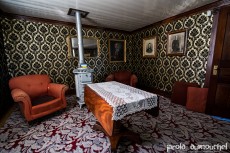His nickname is coming from the stuffed boar's head that adorns the entrance to the castle. Real little jewel of northern France, the secrecy surrounding its location still preserves the vandals who have already done so much damage elsewhere....
The Negro Community Center
Also known as the NCC Charles H. Est Cultural Center
The origins of the building
Despite the many changes made to the building by the Negro community center, it is clear that the original building was a church. Plans are signed by Sidney Rose Badgley (1850-1917), an architect from Ste.Catherine, Ontario.

Crédit photo: © Bibliothèque et Archives nationales du Québec
Built in 1890, the church was named the West End Methodist Church. Despite a major fire that broke out on Christmas Day of 1915 (see image below), the church will continue its activities until 1927 when it will be renamed the West End United Church. Two years later, in 1929, it becomes the Iverley Settlement House. The settlement movement was a reformist social movement who was very popular in the 1920s with the goal of getting the rich and poor in society to live more closely together in an interdependent community. In Montreal, the building was therefore used as a home for immigrants and less affluent families.
The Negro Comunity center
In February 1927 in the living room of the Reverend Charles Humphrey Este, the Negro Community Centre (NCC) was born. With the eleven members of the congregation of the Union United Church, they develop the foundations of the mission they wish to give to their new organism: "improve the social and economic conditions of the black community in Montreal."
Coming from the Caribbean, Este arrives in Montreal in the spring of 1913, nothing has destined Este to become a reverend. One of his first jobs in Montreal was shoe shine boy in front of a hotel in Montreal. One day, a client asked him if it was not the appropriate time to make a man of himself. "Quit this job and take a six month course at MacDonald College and be somebody," he suggests it. After a very trying time, he was accepted at the Congregational College.
After two years of discussions, the Financial Federation of Montreal grants the funds to get started. Constantly looking for more space and moving from a local to another, in July 1955 they have merged the Negro Community Centre and the Iverley Community Centre. Therefore, the building that we know will now be associated with the black community due to the gradual disappearance of the settlement movement. From 1955 to 1957, the community will reap $ 50,000 grant to build a gym on the fourth floor.
In 1987, while a portion of the outer wall at the rear of the Negro Community Center / NCC Charles H. Est Cultural Center, it is clear that the financial troubles of the community are in the image of their building, in big trouble. The following year, the situation becomes increasingly unmanageable when Centraide announced at the general annual meeting of the organization that they will cut its funds.
After several years to find a solution, the center was officially closed in 1994. While many community projects are created to save the building and its mission, they all soldent unfortunately in failure.
A famous visitor
Beyond the various mayors of Montreal who visited repeatedly Negro Center, it was in June 1990 that the center will receive in its walls its most famous visitor: Nelson Mandela. Born in 1918, he was put in jail in 1964. It is released on February 11, 1990 and in the same year (June 19), he was received by Mayor Jean Doré in the Montreal City Hall. Thus, the only other place he visits during his stay in the city will be the Negro Community Center / NCC Charles H. Est Cultural Center.
A wall collapses
Last April 13, one of the walls of the Negro Community Centre collapsed, ripping open a gaping hole that exposed every floor of the three-storey building. Firefighters received the call around 11:30 a.m. and rushed to the scene with specialized equipment to make sure nobody had been buried in the stones and decrepit concrete.
Related content
Popularized by a french CBC tv show, the former Iraqi consulate in Montreal is abandoned since 1980. Built by architect Jacques Vincent, the house is sold to the Consulate of Iraq in 1979 for the amount of $ 365,000. By the way, the same house...
The history of this house is intimately linked to the original owners who came from the island of Jersey, part of the Anglo-Norman Isles. From a wave of immigrants from the Channel Islands of Jersey and Guernsey, they will be hundreds of families...
We are in September 1937 in the small village of Belchite located about 50 kilometers from Zaragoza. The Spanish Civil War has been raging for a year already and thousands of Spaniards died. By the end of the conflict in April 1939, they will be...




















